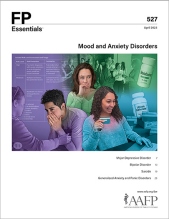
This clinical content conforms to AAFP criteria for CME.
Bipolar I disorder affects approximately 0.4% to 1% of the global population. In the United States, bipolar-related disorders are associated with a significant economic burden because of the functional impairment they cause. Due to long wait times for access to specialist physicians and insurance issues, primary care physicians frequently manage this condition. Up to 4% of patients in primary care have bipolar disorder (BD). The diagnostic criteria for bipolar-related disorders are complex, and screening tools alone are insufficient for identification. Diagnosis involves a comprehensive clinical assessment that often requires multiple visits. Lithium continues to be the gold-standard mood-stabilizing drug for BD management and maintenance therapy in adults. Some anticonvulsants and atypical antipsychotics also have been shown to be effective for maintenance therapy. Ketamine is being studied as a possible future treatment option, but current research does not support its use. Psychotherapy, such as cognitive behavioral therapy and psychoeducation on management strategies, can be a useful adjunct therapy. Mental health clinicians can support primary care physicians in the evaluation and treatment of patients with BD.
Case 2. CV is a 22-year-old man who comes to your office for a follow-up visit for depression management. He has a history of feeling depressed most of the day, anhedonia, poor appetite, significant weight loss without dieting, passive suicidal ideation, and feelings of worthlessness. As a result, he withdrew from his college classes this semester.
Subscribe
From $350- Immediate, unlimited access to FP Essentials content
- 60 CME credits/year
- AAFP app access
- Print delivery available
Edition Access
$44- Immediate, unlimited access to this edition's content
- 5 CME credits
- AAFP app access
- Print delivery available
